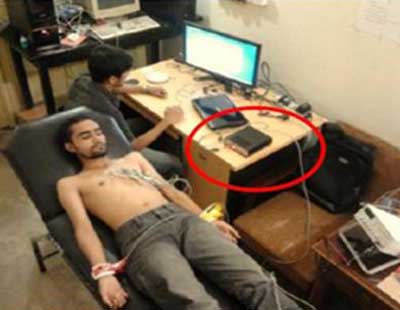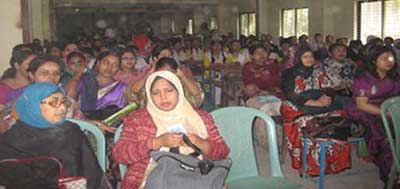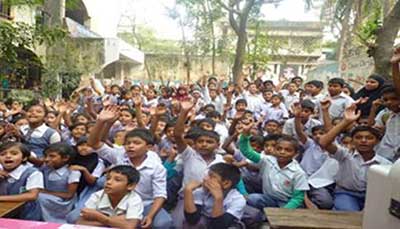Improvement in Education and Research Through Recognition, a Report from Bangladesh
Sultana N. Nahar

Prize winners and University officials.

Prize winning invention by Professor K. Siddique-e-Rabbani. A doctor in a remote village uses a system of a simple computer and to take an ECG and transmit it through the internet to an expert in a hospital

A supportive audience where students cheered when their voted teachers’ names were announced.

Students at Gandaria Mahila Samitee Primary School respond with hands raised to the question: “who wants to be a scientist in the future?”
This report is on a visit to Bangladesh during November-December 2014 in which positive progress in education and physics research was observed since the last visit in 2011[1].
Razzaq-Shamsun Physics Prizes
These are of two kinds, an annual physics research prize I initiated in 1995 with awards beginning in 2000, and a lifetime achievement award initiated in 2008. Competition for these are global throughout Bangladesh and are administered through the University of Dhaka. The objectives of these prizes are to encourage physics research and publication, and especially to encourage people to continue to contribute in research, teaching, and physics related work. It was very satisfying to observe the significant increases compared to past years in the number of publications, and the number of applicants for the prizes. The standards by which excellence is measured have also significantly improved.
Applications came from Dhaka, Chittagong, Jagannath, Jahangirnagar, and Rajshahi universities where most physics research in Bangladesh is carried out. Applications were for the annual Razzaq-Shamsun physics research prizes from 2008 to 2013 and Razzaq-Shamsun lifetime achievement prizes for two years.
The annual prize winners were:- 2008. Prof Md. A.R. Patoary, Rajshahi University, "For study of electron impact ionization using models."
- 2009. Dr. A.F.M. Yusuf Haider, Dhaka University, "For study of semiconductor using laser Raman spectroscopy."
- 2010. Dr. Kamrul Khan, Jagannath University, "For creating sustainable electricity using patharkuchi leaves."
- 2011. Dr. Mohammad Idrish Mia, Chittagong University, "For study of spin effects in semiconductors."
- 2012 Dr. Rezaul Azim, Chittagong University, "For study of ultra wide band antenna with multiple notches."
- 2013 Dr. Muhammad M. Rahman, Dhaka University, "For study of nanohole surface plasmon resonance.”
- Professor K. Siddique-e-Rabbani of Dhaka University, founder of the Biomedical Physics and Biotechnology Department of Dhaka University. "For outstanding contributions in physics applications to affordable health care technology and training of many students in Bangladesh"
- Professor Ajoy Roy of Dhaka University, "For electron-spin resonance work"...
The prize event was an occasion to commemorate some inspiring figures and their contributions. Physics Chair Prof. Azizur Rahman discussed the contributions by Satyen Bose for Bose-Einstein statistics and Professor K.S. Krishnan for his extensive experiments on the Raman Effect under C.V. Raman. Krishnan became widely known and recognized for the study of magnetic properties of crystals with Professors S. Banerjee, B.C. Guha, and A. Mookherjee while he was at Dhaka University. He continued to collaborate with Banerjee and developed the Krishnan Banerjee method for measuring the magnetic susceptibility of small crystals.
Vice Chancellor of Dhaka University, Professor A.A.M.S. Arfen Siddique helped to complete the award process which had been delayed for a number of years. He gave me a certificate of recognition: "For her continuing inspirational and sincere work for promotion of physics research and education in whole Bangladesh" and trophy of Dhaka University.
Physics Teaching, Research and Academic prizes in individual universities
These prizes are instituted in the main research universities. Selection of the best students is not a problem since they are already qualified through their academic achievement in their examinations. The objective of these prizes is to encourage students to make their best effort and compete positively with fellow students. At the end of the prize ceremony at Chittagong University, a student asked permission to speak and expressed his gratitude for the recognition and how inspired he felt to continue his hard work with the prospect of getting attention and joy of receiving recognition.
Faculty members can improve the weak education and research in Bangladesh. The purpose of these prizes is encouragement through recognition of accomplishments. The physics research prize is based on research publications and involvement of graduate students. The teaching prize is based on students learning in-class. In-class learning is very important for a student to avoid the additional expense of a tutor. Only the best students from high schools are able to enter the university after tough admission tests. They have a passion to learn and use the savings of their parents for their education. Very few scholarship are available. The winning teachers are nominated by student votes. These ideas are new in Bangladesh and it is taking time to appreciate, adopt and implement by the institutions.
Rajshahi University in Rajshahi was the most successful in adapting the policies of the prize program. This university went through many troubled times for a long time in the past, but has found the way to concentrate on education and carrying out research more than others. In an enlightened ceremony, three well deserved faculty members received the prizes: Professor Aminul Islam for excellence in teaching, Professor Saleh Naqib for excellence in research, and Professor Alfaz Uddin for lifetime contributions in research. The student scholarship went to a female undergraduate student: Mahmuda Akter.
Jahangirnagar University in Savar has agreed to accept students’ evaluation of teachers conditionally for 5 years and winners for 2013 were selected. Approval of this new concept (to Bangladesh) of student evaluations of teachers also came from various faculty members in Dhaka University and nominations were made by students. However, a few physics faculty members and the administration in Dhaka University strongly opposed this system and stopped those prizes. Similarly, there was opposition in Chittagong and Jagannath universities and award of the prizes was stalled. At the student ceremony in Chittagong University both Pro-Vice Chancellor and Dean of Faculty of Science appealed in their speeches to Physics Department to accept the faculty prizes
STEM Education in Primary, Secondary and Higher Secondary Schools
This is a success story. Maniza Rahman Girls High School adopted students’ evaluation for the best teachers in 2003. This school has seen a reverse in its achievements. Students are performing better. The number getting an A grade in board exams in increasing each year. The school has grown, not only in numbers, from about 500 to 2000 students, it has also expanded to college (higher secondary) programs in several arts subjects.
The two primary schools, one in the city and one in a village, a madrasa all with poor students are making amazing progress. Teachers have become dedicated and are very pleased to hear when their names are announced in the ceremony. More students are getting high grades and government scholarships. Each winning teacher and student receives a certificate and an honorarium. The headmasters tell about the beaming students reporting how their parents appreciated the honored cash prizes and how other parents are encouraging their children to be so honored. In my address to students, I explained how good and helpful knowledge is and how far they can go with discoveries and inventions. When asked of students at each institution who wanted to be a scientist or a great scholar, the students responded with enthusiastic "I want to be" with hands raised.
Reference.- S. N. Nahar, “Recent Visit to Bangladesh Universities and Physics Prizes,” APS Forum on International Physics newsletter spring 2013.
Dr. Sultana N. Nahar is a research professor in the Department of Astronomy at Ohio State University. She has published extensively on radiative and collisional atomic processes in astrophysical and laboratory plasmas, and also worked on dielectronic satellite lines, theoretical spectroscopy, and computational nanospectroscopy for biomedical applications. Sultana Nahar is the winner of the APS 2013 John Wheatley Award. Email: nahar.1@osu.edu
Disclaimer - The articles and opinion pieces found in this issue of the APS Forum on International Physics Newsletter are not peer refereed and represent solely the views of the authors and not necessarily the views of the APS.
